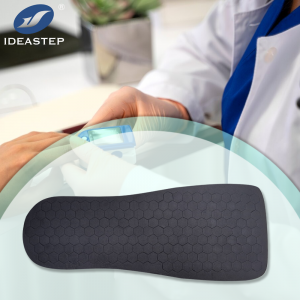
Diabetic insoles, also known as diabetic shoe inserts, play a crucial role in providing support and protection for individuals with diabetes-related foot conditions. When designing diabetic insoles, one of the key considerations is the material hardness, which directly impacts comfort, support, and the prevention of foot complications. In this article, we will explore the importance of material hardness in diabetic insoles and the factors to consider when selecting the appropriate hardness level.
Importance of Material Hardness:
The material hardness of diabetic insoles is a critical factor in ensuring optimal foot health for individuals with diabetes. Proper material hardness can address the following key requirements:
- Pressure Redistribution: Diabetic insoles with the right hardness level can effectively redistribute pressure across the foot, reducing the risk of developing pressure ulcers, also known as diabetic foot ulcers. The material should be soft enough to cushion sensitive areas while providing adequate support to prevent excessive pressure points.
- Shock Absorption: The material hardness should allow for sufficient shock absorption to minimize the impact on the feet during walking and other weight-bearing activities. This is particularly important for individuals with diabetic neuropathy, a condition that affects nerve sensation in the feet.
- Stability and Support: Diabetic insoles need to offer stability and support to help maintain proper foot alignment and reduce the risk of complications such as deformities and joint misalignment. The material should provide enough rigidity to support the arch and heel while accommodating the individual’s specific foot shape.
Factors to Consider for Material Hardness Selection:
When determining the appropriate material hardness for diabetic insoles, several factors should be taken into account:
- Foot Sensitivity: Individuals with diabetes often experience reduced sensation in their feet, making them more susceptible to injuries. The material hardness should be gentle enough to protect sensitive areas without causing discomfort or irritation.
- Activity Level: Consideration should be given to the individual’s activity level and lifestyle. The material hardness should be able to withstand the demands of daily activities while providing adequate cushioning and support.
- Foot Deformities: Some individuals with diabetes may have foot deformities or structural irregularities. The material hardness should be tailored to accommodate these unique foot characteristics while promoting proper alignment and function.
- Shoe Compatibility: The material hardness should be compatible with the individual’s footwear, ensuring a proper fit and function within the designated shoes.
Conclusion:
The material hardness of diabetic insoles is a crucial factor in promoting foot health and preventing complications for individuals with diabetes. By carefully considering the pressure redistribution, shock absorption, stability, and individual foot characteristics, healthcare professionals and individuals can select diabetic insoles with the appropriate material hardness to meet the specific needs of the wearer.
We have designed and produced several different diabetic insoles that are highly suitable for individuals with diabetes. If you are interested in them, you can continue to visit this page (https://www.aideastep.com/diabetes-insole/) and tell us your needs.
